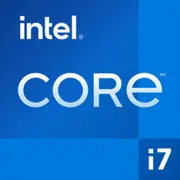Intel Core i7-8086K

Intel Core i7-8086K in 2025: Is It Worth Getting the Coffee Lake Legend?
Architecture, Performance, and Use Cases
Key Specifications: What's Under the Hood?
The Intel Core i7-8086K processor, released in 2018 as a special model to commemorate the 40th anniversary of the x86 architecture, still draws the attention of enthusiasts. Despite its age, its technical specifications remain relevant for a variety of tasks:
- Coffee Lake Architecture: 6 cores and 12 threads thanks to Hyper-Threading.
- 14nm Process Technology: Considered outdated by 2025 standards, but time-tested.
- Base Frequency of 4.0 GHz, Turbo Boost up to 5.0 GHz: High potential for single-threaded workloads.
- 12MB L3 Cache: Optimal for gaming and multitasking.
- Integrated UHD 630 Graphics: Suitable only for basic tasks (office work, 4K video playback).
- TDP of 95W: Moderate power consumption, but increases to 120–130W when overclocked.
Key Features:
- Unlocked Multiplier for manual overclocking — many units run stably at 5.1–5.2 GHz with good cooling.
- Optane Memory Support — relevant for accelerating HDDs in budget builds.
- Intel Turbo Boost Max 3.0 — automatic boosting of the two most efficient cores.
Performance in Tests (Geekbench 6):
- Single-Core: 1677 — comparable to Ryzen 5 5600X (1700–1750).
- Multi-Core: 7023 — lags behind modern 8-core CPUs like Core i5-13400 (8500+).
Compatible Motherboards: What to Choose in 2025?
The processor uses LGA 1151v2 socket, which is compatible only with 300-series chipsets:
- Z370/Z390 — optimal for overclocking (e.g., ASUS ROG Maximus X Hero).
- H370/B360 — suitable for basic builds without overclocking.
Choice Considerations in 2025:
- New motherboards for LGA 1151v2 are no longer being produced. Prices for remaining stock start at $120 for Z390 (e.g., Gigabyte Z390 AORUS Elite).
- Many boards require a BIOS update to work with the i7-8086K. Check the firmware version before purchasing!
- An alternative is the used market, where Z370 can be found for $70–90.
Important: PCIe 3.0 and lack of Thunderbolt 4 support limit compatibility with modern NVMe SSDs and peripherals.
Memory: DDR4 and No Compromises
The i7-8086K supports DDR4-2666 MHz in stock mode. When using Z370/Z390 chipsets, it can be overclocked up to 3200–3600 MHz, which boosts performance in games by 5–10%.
Recommendations:
- Optimal capacity is 16 GB (2×8 GB). For work tasks — 32 GB.
- Popular models: Corsair Vengeance LPX, Kingston HyperX Fury.
- DDR5 and LPDDR5x are not supported — this is a major downside for upgrades in 2025.
Power Supply: How Many Watts Do You Need?
For standard operation, a PSU of 450–500W will suffice (e.g., be quiet! System Power 10 500W). However, for overclocking and powerful graphics cards (e.g., RTX 4060), choose models from 600W with an 80+ Bronze/Gold certification:
- Examples: EVGA 600 BQ, Seasonic FOCUS GX-650.
Tip: Don’t skimp on the PSU — unstable power can shorten the lifespan of the processor.
Pros and Cons: Weighing the Risks
Pros:
- High single-threaded performance for gaming and applications like Photoshop.
- Overclocking potential — relevant for enthusiasts.
- Compatibility with cheap DDR4 and older systems.
Cons:
- No support for PCIe 4.0/5.0, DDR5, Thunderbolt 4.
- The price of new processors in 2025 is $250–300, which is near to Ryzen 5 7600 ($280).
- The outdated 14nm processor generates more heat than modern counterparts (Intel 7nm, TSMC 5nm).
Use Cases: Where is the i7-8086K Still Relevant?
1. Gaming: Paired with a mid-range graphics card like GTX 3060/4060, it can achieve 60+ FPS at Full HD in most games (Cyberpunk 2077, Elden Ring). For 144 Hz monitors, reducing settings may be necessary.
2. Work Tasks: Video editing in Premiere Pro, 3D rendering in Blender—the 6 cores are sufficient for amateur-level work but not for professional studios.
3. Multimedia: Streaming, 4K decoding — it handles tasks but under heavy load (80–90%).
Real Example: A streaming build — i7-8086K + NVIDIA RTX 3060 + 32 GB DDR4. In OBS with NVENC encoding, CPU usage doesn’t exceed 50%.
Comparison with Competitors: Who's Better in 2025?
- AMD Ryzen 5 5600X ($180): Less heat generation, PCIe 4.0 support, but lower stock frequency.
- Intel Core i5-13400 ($220): 10 cores (6P + 4E), DDR5 support, but locked multiplier.
- Ryzen 5 7600 ($280): 5nm, DDR5, PCIe 5.0 — a clear favorite, but requires an expensive AM5 motherboard.
Conclusion: The i7-8086K falls short against new CPUs in multi-threaded tasks but benefits from lower used market prices.
Practical Build Tips
1. Cooling: A cooler like the DeepCool AK620 or NZXT Kraken X53 for overclocking.
2. Motherboard: Look for Z390s with VRM modules covered by heatsinks (e.g., MSI MPG Z390 Gaming Pro Carbon).
3. BIOS: Update to the latest version to fix vulnerabilities (e.g., Spectre).
4. Graphics Card: Avoid models beyond RTX 4070 — the processor will become a "bottleneck".
Final Conclusion: Who Is the i7-8086K Suitable For?
This processor is worth considering for:
- Enthusiasts wanting to experiment with overclocking.
- Owners of older systems on LGA 1151v2 looking to upgrade without changing the motherboard.
- Budget gamers seeking to save on components using DDR4 and used parts.
Why You Shouldn't Buy: If you're planning a "future-proof" build with DDR5 and PCIe 5.0 — it’s better to choose Ryzen 5 7600 or Core i5-14400.
In 2025, the i7-8086K is a niche solution for those who value the balance of price and performance within an established ecosystem.
Basic
CPU Specifications
Memory Specifications
GPU Specifications
Miscellaneous
Benchmarks
Compared to Other CPU
Share in social media
Or Link To Us
<a href="https://cputronic.com/index.php/cpu/intel-core-i7-8086k" target="_blank">Intel Core i7-8086K</a>